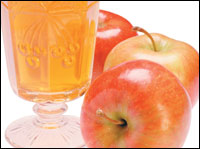
My youngest went to the farm this spring.
And I had to call and warn the principal.
You know the drill: Hordes of kindergarten-aged children cram into a school bus for a trip down the dusty roads of memory lane where animals and plants flourish in pastoral settings, and all food is natural.
But why the phone call?
Two years ago I accompanied one of my other four daughters on a similar trip. After petting the animals and touring the crops -- and questioning the fresh manure I saw on strawberries -- we were assured that all the food produced was natural. We then returned for unpasteurized apple cider. The host served the cider in a coffee urn, heated, so my concern about it being unpasteurized was abated. However, given the number of outbreaks of E. coli O157:H7 with unpasteurized cider, most famously the Odwalla juice outbreak of 1996, I asked the owner, "Did you serve the cider heated because you heard about other outbreaks and were concerned about liability?"
"No," she responded, "the stuff starts to smell when it's a few weeks old and heating removes the smell."
The problem is that no matter how many outbreaks, no matter how many on-farm food safety guidelines and manuals are out there, no matter how many media accounts and political investigations, the message will not reach everyone. I called the principal because my youngest was returning to the same farm.
This basic risk question -- how does this affect me? -- is one of the hardest to answer, and seems almost impossible when greeted with the language of risk assessment. Listeria monocytogenes presents an even more difficult scenario. From the fall of 1998 through 1999, some 80 people across the U.S. were stricken with listeria associated with hot dogs made at Sara Lee's Bil Mar plant in Michigan, and over a dozen died. Consumers may know to cook their hamburgers, but hot dogs? Deli meats? Soft cheeses?
Recently, several U.S. agencies completed and published a risk assessment of Listeria monocytogenes in ready-to-eat foods (http://www.foodsafety.gov/~dms/_lmrisk.html). The document provides an excellent overview of the scientific challenges - especially for food processors - in controlling listeria. But when it comes to questions that a parent might have- should my child eat raw wieners? - the document speaks of median incidence per 100 million servings and divides the population into three groups of varying susceptibility.
Maybe my kids could eat 100 million wieners if I let them.
Such challenges are absolutely normal in the world of risk. For industry, government and others, the only real hope is to talk about risk reduction: to make a pact with the public; to frankly state, here's where we are today, here's where we are trying to go and how we're going to get there; and if there are any problems or changes along the way, you'll hear it from us first.
But how can the language of risk reduction work in a zero-tolerance environment?
Poorly.
Zero tolerance is the equivalent of mandatory labeling of genetically engineered foods - sugary sound bites that sound tempting but inevitably leave one unsatiated and, in some cases, hyperactively running around, making proclamations in the absence of substance. The report correctly states that, "it is generally recognized that achieving additional reductions in foodborne listeriosis can only be realized by applying the best available scientific knowledge in the review of current programs and policies and developing new initiatives."
Fair enough.
But what can industry and government say to someone like Wyoming Public Schools director of operations Bill Nelson, who at the time of the Bil Mar outbreak was quoted as telling the Grand Rapids Press that, "We are serving no hot dogs, no lunch meat and no turkey-type products. I don't care who makes them."
Risk reduction and continuous improvement may sound boring. They are not going to magically change minds. But over the long haul they are the basis for an ever safer food supply.